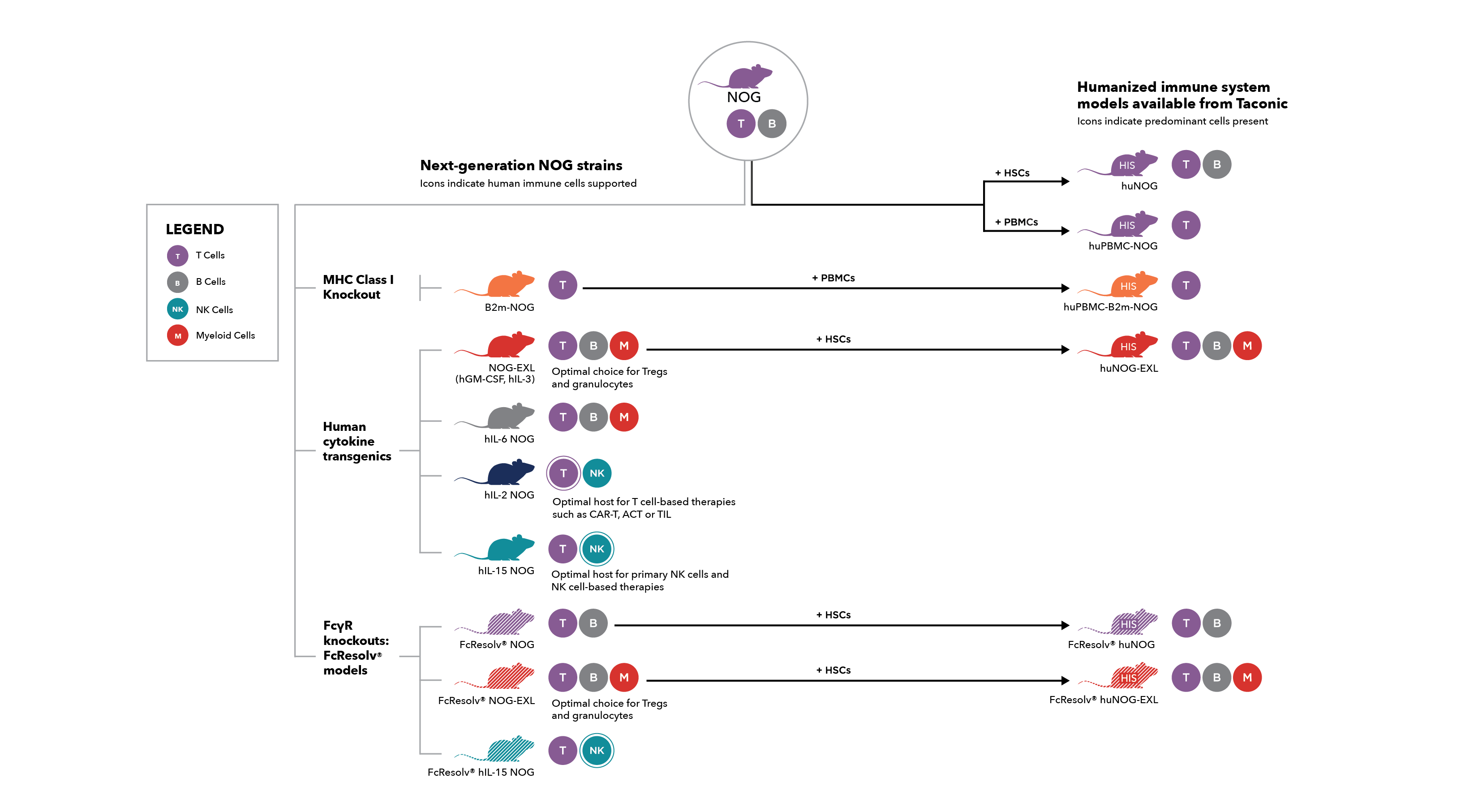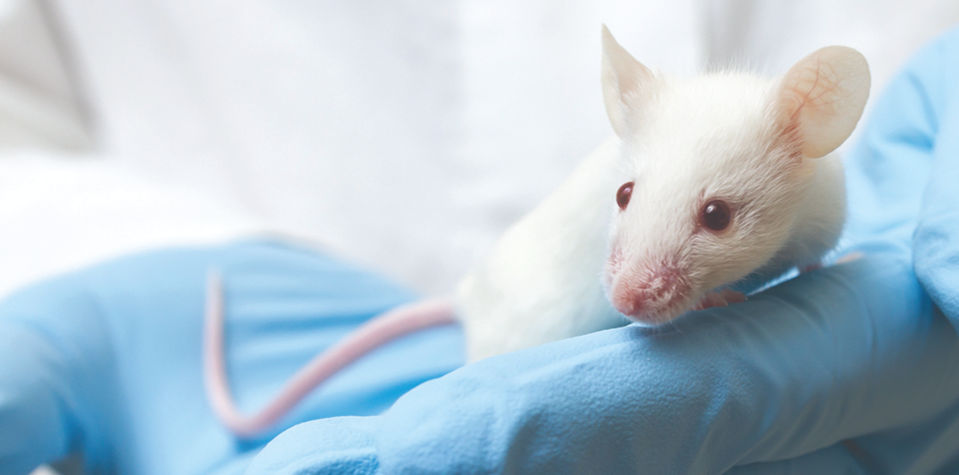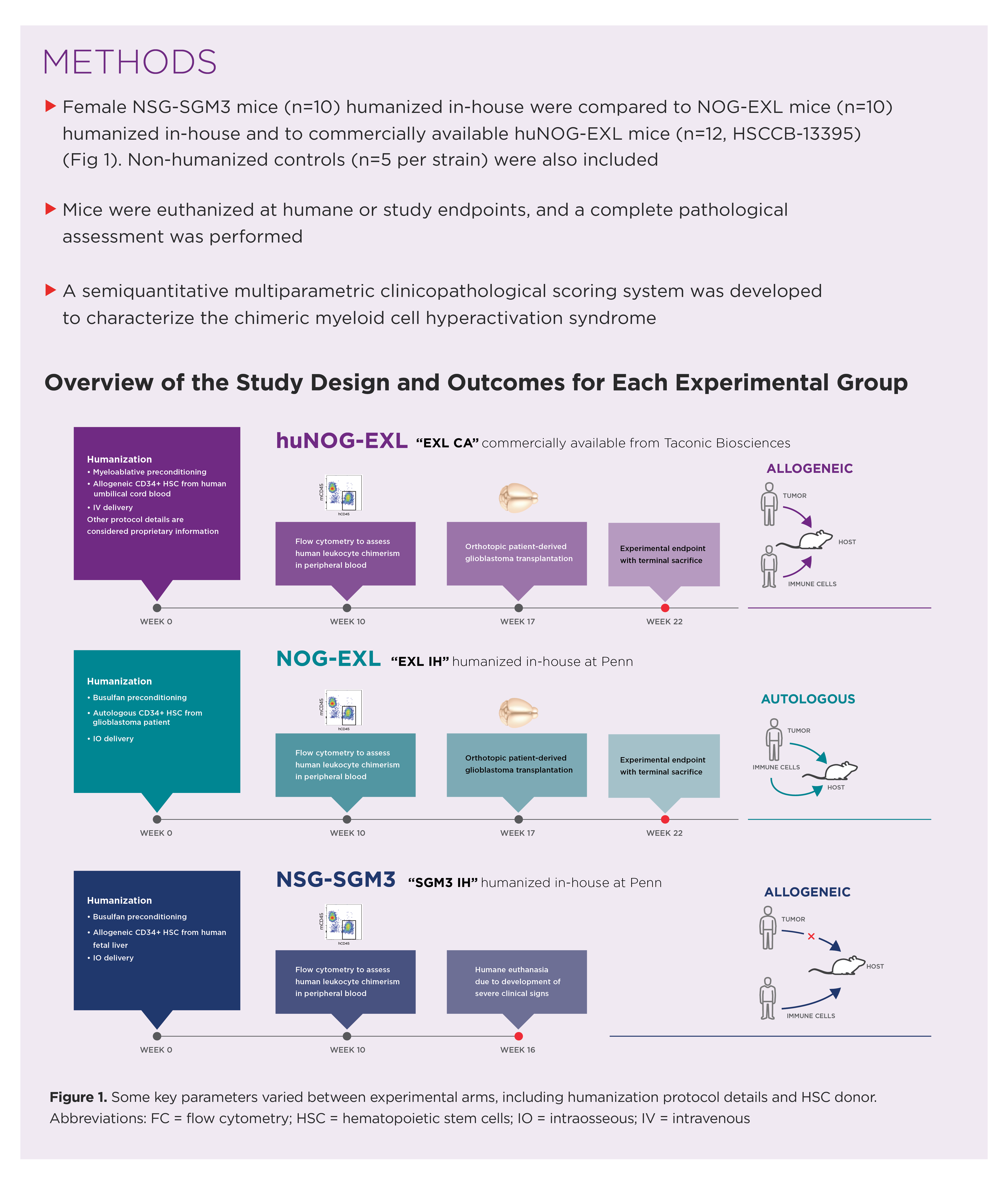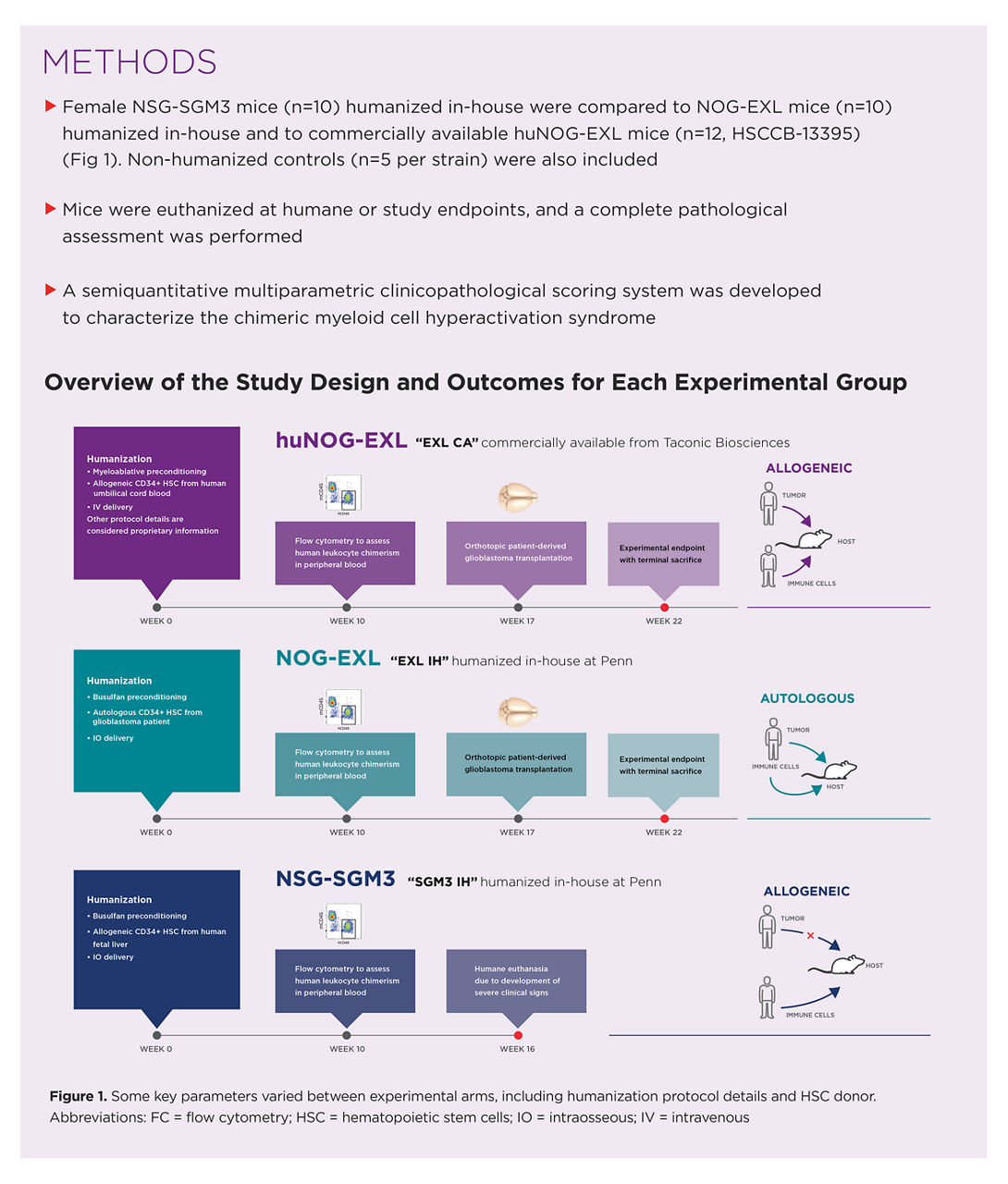Researchers at the University of Pennsylvania (Penn) sought to recapitulate key features of glioblastoma in a mouse model following unsuccessful attempts with other models. Co-authors of the study are part of the Comparative Pathology Core and Stem Cell and Xenograft Core, and the University of Pennsylvania’s Glioblastoma Multiforme Translational Center of Excellence, which seeks to create novel therapeutics to be used in glioblastoma studies, in part by establishing disease models that recapitulate key features of disease without succumbing to severe adverse events. Previous attempts to study glioblastoma using the NSG-SGM3 mouse failed; all humanized NSG-SGM3 mice died before glioblastoma engraftment. The scientists approached Taconic with their concerns and were presented with the NOG-EXL model, which was then used in subsequent studies to determine survivability. This study also allowed researchers to characterize myeloid cell hyperactivation, a biological process that severely limits the use of mouse models in long-term studies.
Study Reveals Improved Outcomes in NOG-EXL Model
NOG-EXL Mouse Model Outperforms NSG-SGM3, According to New Paper Authored by Scientists at the University of Pennsylvania and Taconic Biosciences
Researchers analyzed:
- NSG-SGM3 mice humanized in-house at Penn with allogeneic transplants (SGM3 IH)
- NOG-EXL mice humanized in-house at Penn with autologous transplants (EXL IH)
- huNOG-EXL mice available off-the-shelf from Taconic underwent allogeneic transplants (EXL CA)
Mice from the two NOG-EXL groups reached the experimental endpoint of 22 weeks after humanization while the SGM3-IH group was unable to continue; mice were humanely euthanized at 16 weeks after humanization. Overall, the researchers noted the longer lifespans of the humanized NOG-EXL mice and much less severe adverse outcomes compared to the humanized NSG-SGM3 mice. NSG-SGM3 mice displayed signs of more severe myeloid hyperactivation syndrome (MCH), including higher levels of leukocytes and more widespread lesions in various organs, making them unsuitable for long-term glioblastoma investigations. In particular, mast cell infiltration severely affected the pancreas in mice of the NSG-SGM3 group. In the liver, severity was consistent across groups, but not lesion quality. Hepatocellular necrosis in NSG-SGM3 mice was more common. Willis et al. concluded that NOG-EXL mice are more clinically stable following humanization, regardless of being humanized in-house or commercially within Taconic.
This successful collaboration has led to several conference posters and presentations, and, most recently, a publication in Veterinary Pathology.

Taconic offers a comprehensive portfolio of models for immuno-oncology studies, including the NOG-EXL and the huNOG-EXL model.
Connect with a field application scientist to discuss which model is right for your next study, or call 1-888-TACONIC (888-822-6642) in the US, +45 70 23 04 05 in Europe, or email info@taconic.com.
About Taconic Biosciences, Inc.
Taconic Biosciences is a fully licensed, global leader in genetically engineered rodent models and services. Founded in 1952, Taconic provides the best animal solutions so that customers can acquire, custom-generate, breed, precondition, test, and distribute valuable research models worldwide. Specialists in genetically engineered mouse and rat models, microbiome, immuno-oncology mouse models, and integrated model design and breeding services, Taconic operates service laboratories and breeding facilities in the U.S. and Europe, maintains distributor relationships in Asia, and has global shipping capabilities to provide animal models almost anywhere in the world.
Media Contacts:
For scientific inquiries:
Moriah Jacobson, PhD,
Field Applications Scientist
Schedule A Scientific Consultation
Speak with a PhD-level Field Application Scientist who can help you select the most appropriate model and maximize your experimental success.
Researchers at the University of Pennsylvania (Penn) sought to recapitulate key features of glioblastoma in a mouse model following unsuccessful attempts with other models. Co-authors of the study are part of the Comparative Pathology Core and Stem Cell and Xenograft Core, and the University of Pennsylvania’s Glioblastoma Multiforme Translational Center of Excellence, which seeks to create novel therapeutics to be used in glioblastoma studies, in part by establishing disease models that recapitulate key features of disease without succumbing to severe adverse events. Previous attempts to study glioblastoma using the NSG-SGM3 mouse failed; all humanized NSG-SGM3 mice died before glioblastoma engraftment. The scientists approached Taconic with their concerns and were presented with the NOG-EXL model, which was then used in subsequent studies to determine survivability. This study also allowed researchers to characterize myeloid cell hyperactivation, a biological process that severely limits the use of mouse models in long-term studies.
Researchers analyzed:
- NSG-SGM3 mice humanized in-house at Penn with allogeneic transplants (SGM3 IH)
- NOG-EXL mice humanized in-house at Penn with autologous transplants (EXL IH)
- huNOG-EXL mice available off-the-shelf from Taconic underwent allogeneic transplants (EXL CA)
Mice from the two NOG-EXL groups reached the experimental endpoint of 22 weeks after humanization while the SGM3-IH group was unable to continue; mice were humanely euthanized at 16 weeks after humanization. Overall, the researchers noted the longer lifespans of the humanized NOG-EXL mice and much less severe adverse outcomes compared to the humanized NSG-SGM3 mice. NSG-SGM3 mice displayed signs of more severe myeloid hyperactivation syndrome (MCH), including higher levels of leukocytes and more widespread lesions in various organs, making them unsuitable for long-term glioblastoma investigations. In particular, mast cell infiltration severely affected the pancreas in mice of the NSG-SGM3 group. In the liver, severity was consistent across groups, but not lesion quality. Hepatocellular necrosis in NSG-SGM3 mice was more common. Willis et al. concluded that NOG-EXL mice are more clinically stable following humanization, regardless of being humanized in-house or commercially within Taconic.
This successful collaboration has led to several conference posters and presentations, and, most recently, a publication in Veterinary Pathology.
Schedule A Scientific Consultation
Speak with a PhD-level Field Application Scientist who can help you select the most appropriate model and maximize your experimental success.
The Taconic NOG Portfolio of superimmunodeficient and humanized immune system mice
The NOG mouse offers many advantages over standard nude and scid strains, particularly for engraftment of challenging cell lines, patient-derived xenografts, and immune system humanization.

FcResolv® NOG Portfolio
Super immunodeficient mouse models with murine Fc gamma receptors knocked out provide improved accuracy in antibody-based studies.
Researchers who work with antibody-based therapies find that murine Fc gamma receptors (FcγRs) can confound preclinical study results, causing false positives or false negatives that lead to incorrect conclusions and derail drug discovery. By knocking out these receptors, FcResolv® NOG models provide clarity in antibody-based drug studies, offering greater confidence and more translatable data while utilizing fewer resources.

















.jpg)

.jpg)
.jpg)
.jpg)
.jpg)





.jpg)


.jpg)
.jpg)




.jpg)




.jpg)

.jpg)











